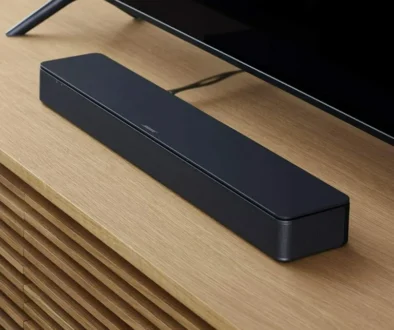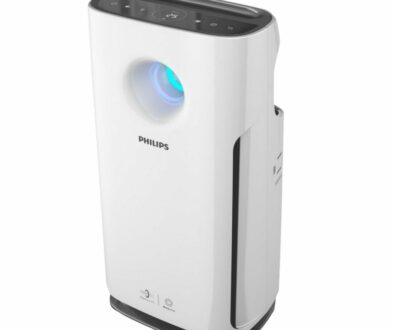Smart Home Air Quality Monitors: know the air that you breathe
Keeping the air fresh and clean at home leads directly to a healthier and more active you. The average adult breathes a total of about 11,000 litres of air per day. That is a lot of air going in and out of your body as you inhale and exhale. So start monitoring the air quality at home with one of these smart air quality monitors.
You Are What You Breathe
Keep everyone at home safe with one of these smart air quality monitors. These nifty gadgets have the ability to detect a variety of harmful airborne particles and alerting you so you can take the appropriate action. Use an air filter, open the window, switch on the exhaust fan, order a deep carpet clean, muster up the energy to do a proper spring clean or simply take a short vacation and get the cleaners in are some of your options.
Indoor air pollution can be caused by poor ventilation. Keep your room clean and circulate the air in the room at least once a day.
Modern air quality monitors also detect Volatile Organic Compounds (VOCs). VOCs are organic chemicals that vaporises at normal room temperature and permeates the air in enclosed rooms. These molecules enters the ambient air and as you inhale, moves into your body. The chemical compounds are either natural or man-made and are released from paint, cleaning detergent or aerosols, some of which are dangerous to the human body in the long term.
As for the airborne particles, these sensors can detect PM 2.5, fine particles equal to or less than 2.5 microns in diameter. These particles are so small that they go into our respiratory system and cause harmful effects to the body. As they are smaller, they also stay longer in the air than compared to bigger dust particles so we are more susceptible to breathing them in.
Next to PM 2.5 air particles and Volatile Organic Compounds, advanced air monitors can also pick up carbon dioxide level, humidity and temperature. Some air quality monitors offer the option of a remote sensor that you can place outside to check the air quality index around your area. You best option is to combine an air quality monitor with an air purifier if one is not built-in to help clean and neutralise the air at home.
Do You Need One
If you work from home, have little ones in the house, suffers from dust or pollen allergies, dealing with asthma, eczema or generally just want better well being and health than an air quality monitor helps you achieve that. Dust and pollen can cause allergies and asthma attacks. Dry air can cause itchy skin and exacerbate skin conditions such as eczema.
On the other hand, high humidity level can cause mould, mildew and bacteria to grow. A balanced humidity level can help manage asthma and allergies. Next, knowing that your room is set at the right temperature helps you and your child especially toddlers feel more comfortable during the day as well as at night. These are some of the benefits of an air quality monitor.
Bottom line is, knowing that the air you are breathing is safe gives you peace of mind. Receiving timely alerts so you can take the corrective measures when the indoor air is polluted to an unhealthy level especially with chemicals and toxins trapped in the house ensures that you are not exposed to harmful levels of these chemicals.
How Best to Make the Most of Your New Air Quality Monitor
Now if you already have an air quality monitor, here are a few tips to the most out of it. The best place for your air quality monitor is in the middle of the room. This is typically on the coffee table in the living room, on the dining table in the dining room, on a side table or console in the bedrooms and the counter top in the kitchen. Do not put the unit too high up or too low down. If you want to know how the whole house is doing, get multiple of these, one for each room for maximum coverage.
It’s pointless having the information and not taking the correction steps to improve the air quality in the room. Once you have a stable reading, spend some time looking at the recommendations and tips as to how to improve the air quality in the room. Do you need to open the windows, switch on the fan, remove the offending source of give the room a deep clean. Once you have taken the corrective measures, check again in a couple of hours to make sure that things have improved.
To keep things under control, make sure that you set the notifications on your app to alert you when things happen to go south again. You can also add plants in your house and serves to keep the air clean. You can find a long list of plants that act as nature’s air purifier and can help tremendously with the air quality indoor. You can find a quick sample of plants that care for the air in your home in the image below. These go by their more familiar house names such as Peace Lily, Chrysanthemum, Weeping Fig, Snake Plant, Dracaena, Spider Plant and Aloe Vera. All which can be grown indoor.

The last tip we have for you to make the most of your air quality monitor is to pair it with a smart device be it a smart plug for a fan, an air purifier or air conditioner. That way, the cleaning and airing process is automated, short of opening the doors and windows to let fresh air in, these digital ‘recipe’s be it on the companion app, Alexa or IFTTT can help react automatically to the condition in your room.
Top 5 Best Air Quality Monitors
We take a look at five of the best air quality monitor in the market. You can click on the links below to find out more from online retailer.
1. Airthings 2930 Wave Plus
The Airthings 2930 Wave Plus is a state-of-the-art smart air quality monitor designed to provide comprehensive insights into the indoor environment. Renowned for its precision and ease of use, this device is equipped to detect a range of air quality indicators including radon levels, which is a unique feature compared to many other air quality monitors. Additionally, it monitors carbon dioxide (CO2), volatile organic compounds (VOCs), humidity, temperature, and atmospheric pressure, making it an ideal choice for health-conscious individuals and families seeking to maintain a healthy living space. With its user-friendly interface and seamless integration with smartphone apps, the Airthings 2930 Wave Plus represents a significant step forward in home health technology.
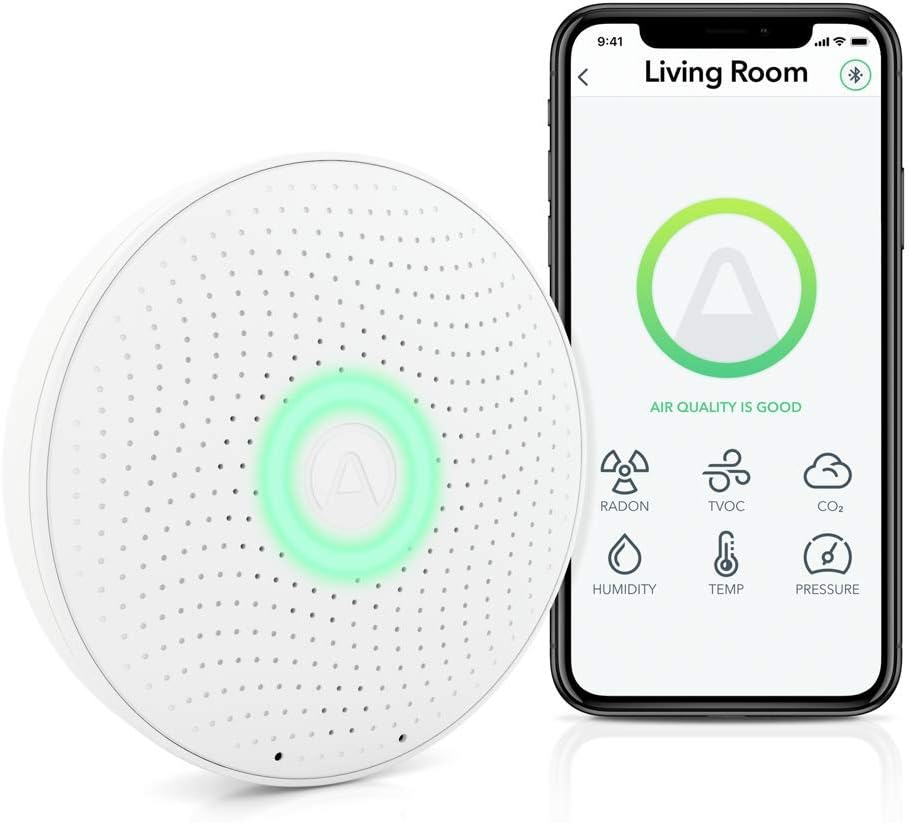
- Radon Detection: Unique ability to detect radon levels, a colorless, odorless gas that is a leading cause of lung cancer.
- Multiple Air Quality Sensors: Monitors carbon dioxide (CO2), volatile organic compounds (VOCs), humidity, temperature, and atmospheric pressure.
- Smartphone App Compatibility: Offers easy access to data and insights through its user-friendly app.
- Wave Feature: A simple gesture of waving in front of the device provides a visual indication of the current air quality.
- Long Battery Life: Designed to operate for up to 16 months on standard AA batteries.
- Wireless Connectivity: Connects to your home WiFi for real-time data monitoring and updates.
- Easy Installation: Simple setup process and can be placed on a wall or a shelf.
- Data Logging and Analysis: Stores historical data for trend analysis and long-term monitoring.
- Smart Home Integration: Compatible with various smart home systems for integrated home environment management.
2. Amazon Smart Air Quality Monitor
The Amazon Smart Air Quality Monitor is an innovative device designed to elevate your home’s health and safety by keeping a vigilant eye on indoor air quality. This compact and sleek monitor is engineered to detect a range of air pollutants and factors, such as particulate matter (PM2.5), volatile organic compounds (VOCs), carbon monoxide (CO), humidity, and temperature. Its integration with Alexa allows for seamless interaction and real-time updates about your indoor environment. Ideal for households looking to ensure a clean and safe indoor atmosphere, the Amazon Smart Air Quality Monitor not only provides precise measurements but also offers actionable insights and alerts, helping users maintain optimal air quality in their living spaces.
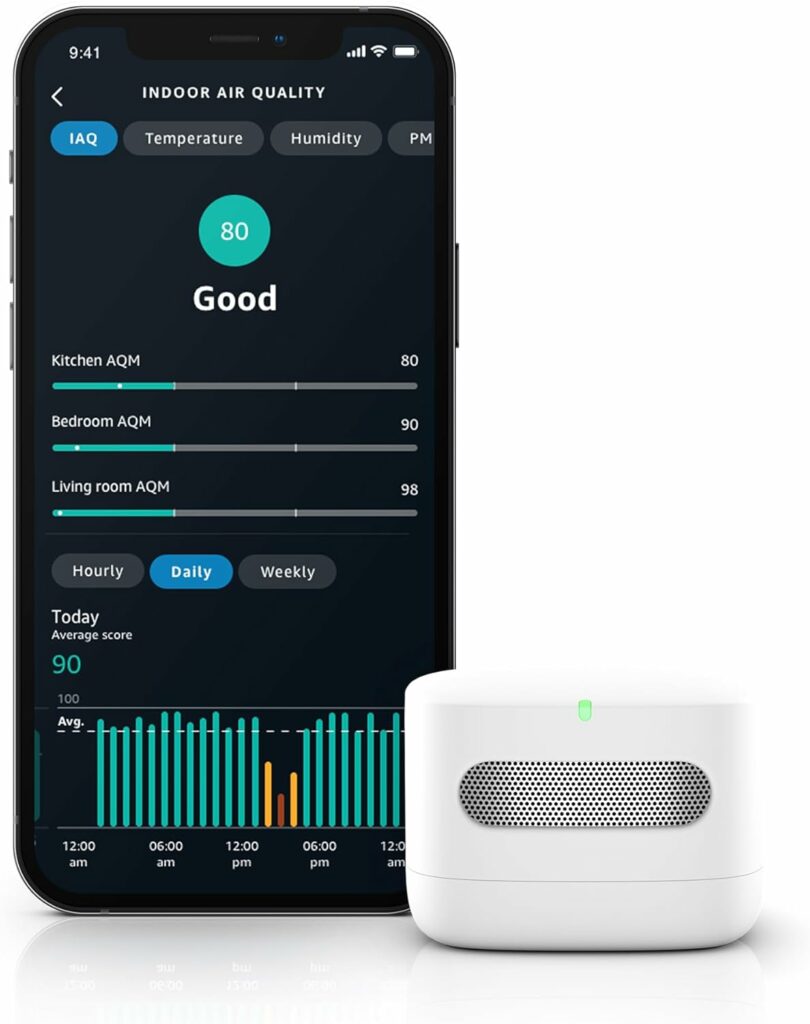
- Comprehensive Air Quality Monitoring: Tracks a variety of air quality indicators including particulate matter (PM2.5), volatile organic compounds (VOCs), carbon monoxide (CO), humidity, and temperature.
- Alexa Integration: Seamlessly integrates with Alexa for voice-activated updates and alerts about air quality.
- Real-Time Alerts: Provides immediate notifications and alerts when air quality deteriorates.
- Compact and Sleek Design: Features a small, modern design that can easily blend into various home environments.
- Easy Setup: Designed for straightforward installation and setup, making it user-friendly.
- Historical Data Tracking: Allows users to view historical air quality data, helping to identify trends and make informed decisions.
- Actionable Insights: Offers recommendations and tips to improve indoor air quality based on the data collected.
- LED Indicator: Equipped with an LED light that changes colour based on the current air quality status.
3. Airthings 2960 View Plus
A second indoor air quality monitor from Airthings, this time the Airthings 2960 View Plus. This advanced device stands out for its ability to track a wide array of air quality indicators, including particulate matter (PM2.5 and PM1), carbon dioxide (CO2), volatile organic compounds (VOCs), humidity, temperature, atmospheric pressure, and even radon levels. With its sleek, modern design and an intuitive display, the View Plus seamlessly integrates into any home or office. It offers detailed insights and data through a user-friendly app, enabling users to monitor and improve their indoor air quality with ease.
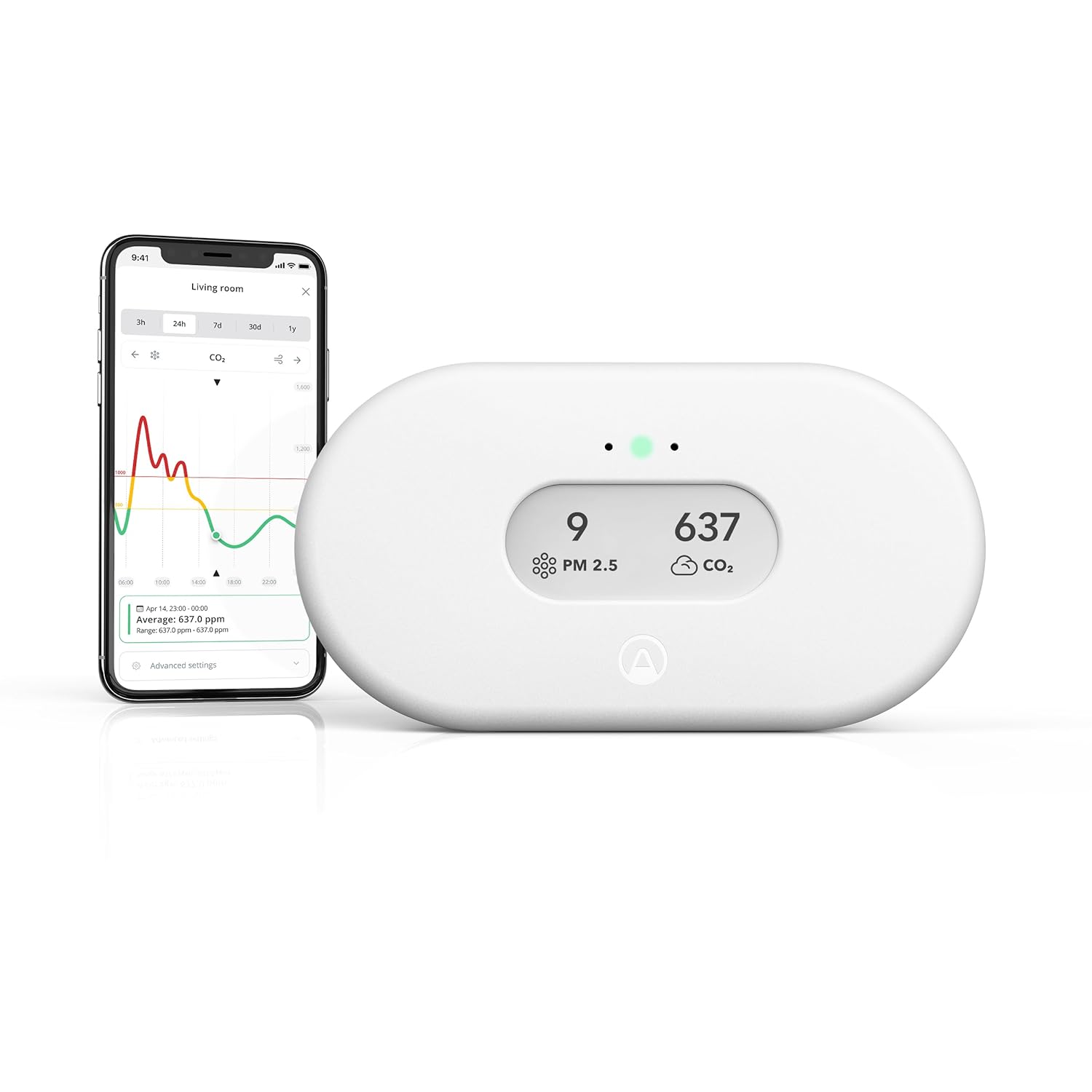
- Wide Range of Air Quality Measurements: Tracks particulate matter (PM1 and PM2.5), carbon dioxide (CO2), volatile organic compounds (VOCs), humidity, temperature, atmospheric pressure, and radon levels.
- Customizable Display: Features a user-friendly and customizable display for easy viewing of air quality data.
- Smartphone App Integration: Offers detailed insights and historical data through its comprehensive app.
- Long Battery Life: Designed for long-term use with a battery life of up to 2 years.
- Wireless Connectivity: Connects easily to WiFi for real-time data monitoring and software updates.
- Easy Installation: Can be set up quickly and placed on a wall or shelf.
- Smart Home Compatibility: Integrates with various smart home systems for a connected home experience.
- Actionable Insights: Provides recommendations for improving indoor air quality based on collected data.
- Sleek Design: Modern and minimalistic design, making it a stylish addition to any room.
4. IQAir Air Quality Monitor Indoor
The IQAir Air Quality Monitor Indoor is renowned for its accuracy in detecting a wide range of air pollutants, including particulate matter (PM2.5 and PM10), volatile organic compounds (VOCs), carbon dioxide (CO2), and other harmful gases. With its advanced sensor technology, the IQAir Monitor offers real-time air quality readings, ensuring users are always aware of the conditions in their home or office. Its sleek design and intuitive interface, coupled with a comprehensive smartphone app, make it a user-friendly choice for those seeking to understand and improve their indoor air quality. The biggest selling point has to be its large full colour display and user friendly interface.
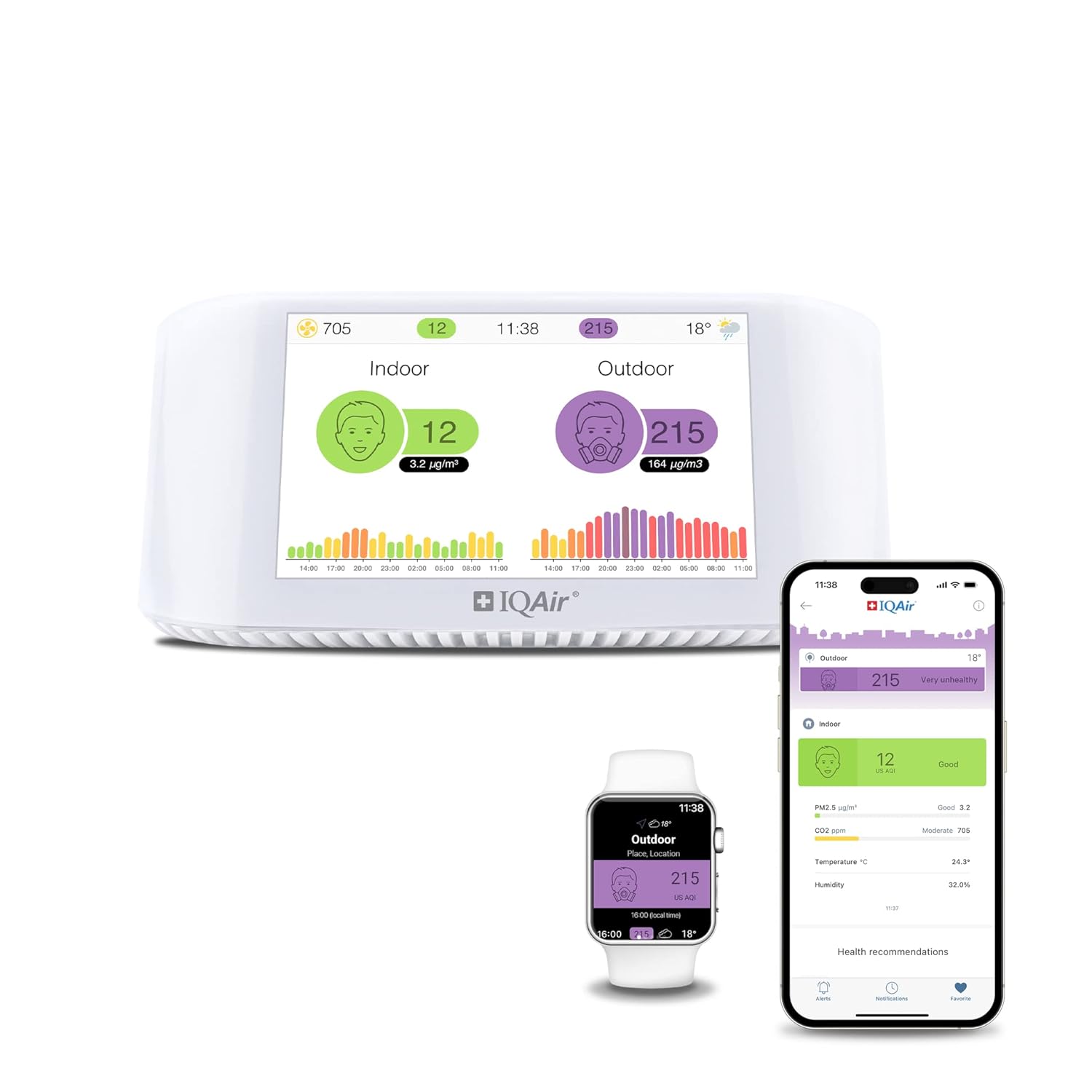
- Advanced Air Quality Sensors: Measures particulate matter (PM2.5 and PM10), volatile organic compounds (VOCs), carbon dioxide (CO2), and other harmful gases.
- Real-Time Air Quality Readings: Provides immediate feedback on the indoor air quality.
- High Accuracy and Precision: Known for its precise detection of various air pollutants.
- Smartphone App Integration: Comes with a comprehensive app for detailed insights and historical data analysis.
- User-Friendly Interface: Features an intuitive design for easy monitoring and navigation.
- Customizable Alerts and Notifications: Allows users to set specific thresholds for alerts on air quality changes.
- Wi-Fi Connectivity: Enables remote monitoring and updates through a Wi-Fi connection.
- Sleek and Modern Design: Has a contemporary aesthetic that fits well in various indoor settings.
- Data Export Options: Offers the ability to export data for further analysis or record-keeping.
5. Awair Element
The Awair Element is a sophisticated smart air quality monitor designed to keep track of your indoor environment’s health and comfort. It stands out for its ability to accurately measure a range of critical air quality indicators, including particulate matter (PM2.5), volatile organic compounds (VOCs), carbon dioxide (CO2), temperature, and humidity. With its sleek, minimalist design, the Awair Element seamlessly integrates into any home or office setting. It is particularly user-friendly, offering real-time feedback through a clear display and a companion smartphone app.
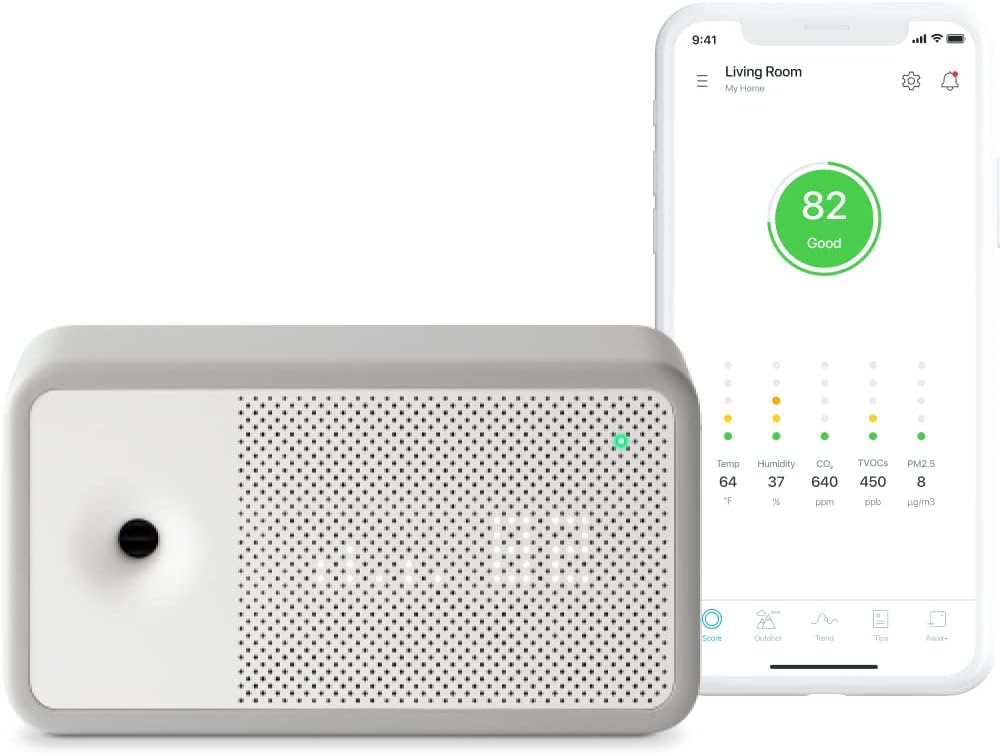
- Air Quality Tracking: Measures a wide range of air quality factors including particulate matter (PM2.5), volatile organic compounds (VOCs), carbon dioxide (CO2), humidity, and temperature.
- Real-Time Monitoring: Provides immediate feedback and readings of the air quality in your environment.
- Smartphone App Integration: Comes with a user-friendly app that displays historical data, trends, and gives personalized recommendations to improve air quality.
- Smart Home Compatibility: Can integrate with other smart home devices and systems for automated home environment management.
- Customizable Display: The device features an LED display that can be customized to show the most pertinent air quality information based on the user’s preference.
- Data Insights and Tips: Offers insights into the air quality data it collects and provides tips on how to improve indoor air quality.
- Sleek and Modern Design: The device has a minimalistic and modern aesthetic, making it a discreet addition to any room.
- WiFi Connectivity: Connects to your home WiFi network for remote monitoring and updates.
Eve Room – Indoor air quality
Specialising in the detection of volatile organic compounds (VOCs), the Eve Room indoor air quality also accurately measures temperature and humidity, providing a comprehensive overview of your indoor environment. Its compact and elegant design, coupled with a high-contrast e-ink display, makes it both functional and aesthetically pleasing. The Eve Room is particularly notable for its integration with Apple HomeKit, allowing seamless connectivity with other smart home devices and enabling voice control through Siri. This feature-rich monitor is an excellent choice for Apple users who are keen on maintaining an optimal indoor atmosphere, ensuring both well-being and environmental awareness in the home.
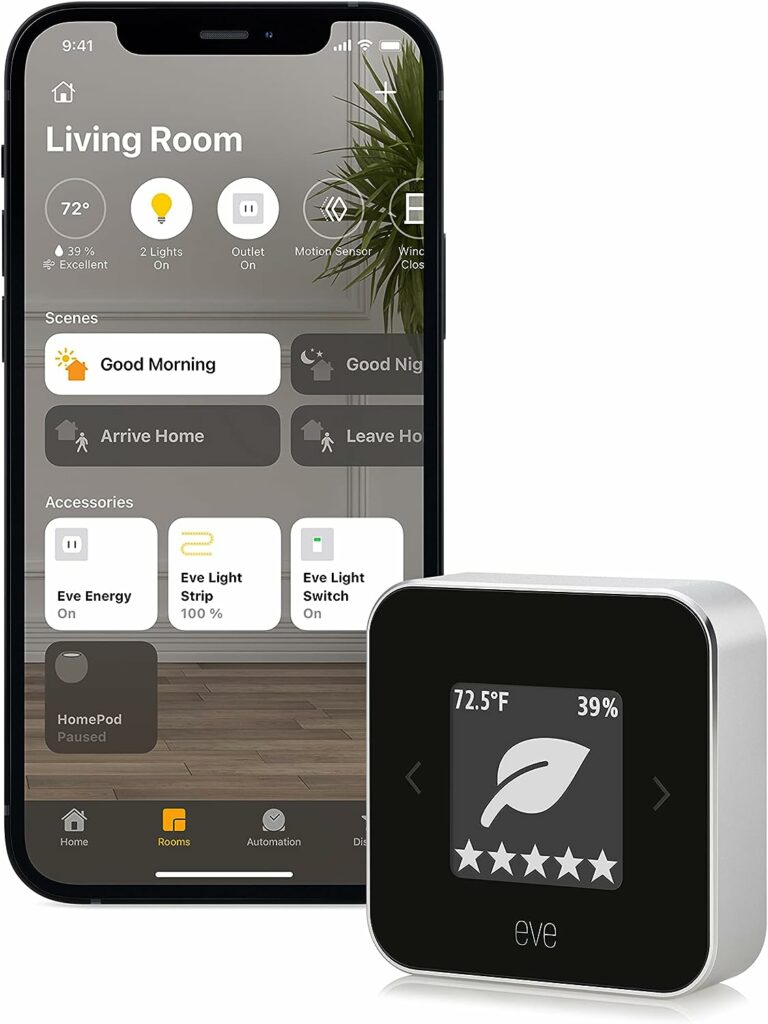
Netatmo Healthy Home Coach
Netatmo Healthy Home Coach measures the vitals of your home and alerts you when something needs to be fixed. It is also one of the more affordable options when compared to other air quality monitor. It not only tracks air quality level, humidity and temperature but noise, something that the other monitors do not do. The later is to ensure that you have the best noise level for a sound sleep. The Healthy Home Coach measures these parameter and highlights potential problems as well as let you know how to fix them. It has a simply cylindrical design with a bar of light on the front that only comes on when you tap on the top of the unit for a visual report of the current air quality level in the room. You may find more information using the Healthy Home app. If you have more than one of these in your home, the App lets you have an overview of your entire home as well as the air quality in each room.
While the design is solid and the app is cleverly developed, it lacks sensors to read the dust or particulate level or volatile organic compounds putting it somewhat lower on our list. However, it compensates for this with its noise level monitor which is great if you want to make sure that you watching the TV downstair is not disturbing your little one in the nursery or baby room relying on the app off course, without leaving your favourite TV show.
Features:
- Air quality level, humidity, temperature and noise monitor
- Advice on how to create a healthier environment
- 3 profiles in APP: baby, person with asthma, general
- Works with Apple HomeKit
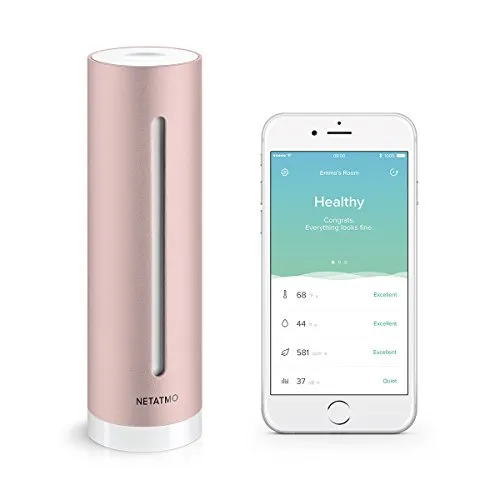
Click Here for Previously Featured Smart Air Quality Monitor





